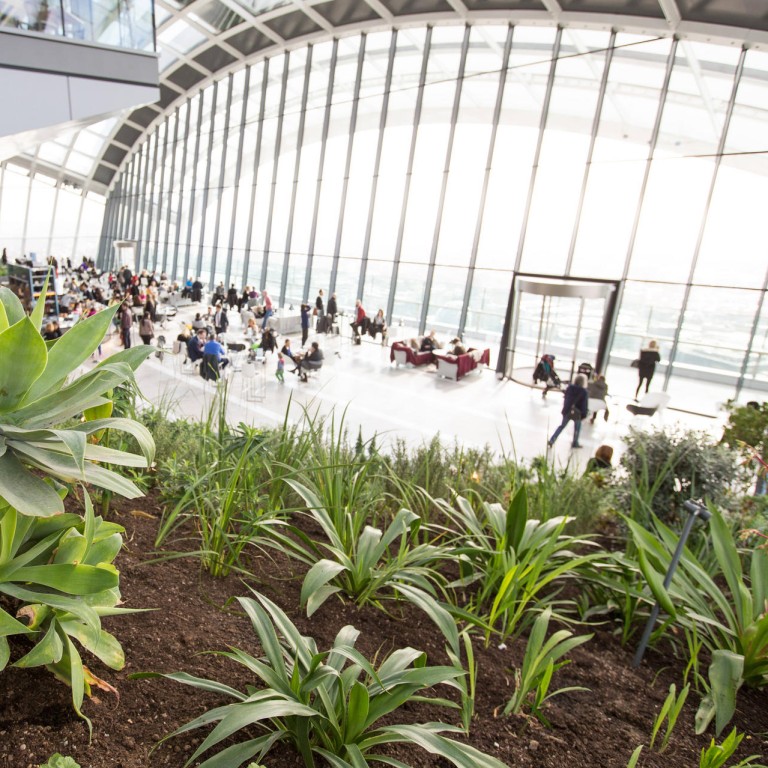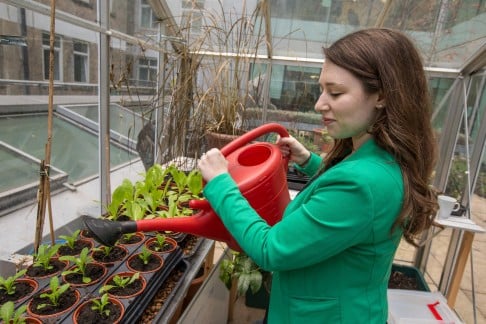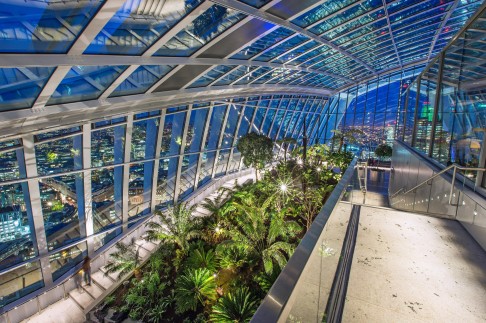
How green rooftops and vertical gardens are transforming London
From green roofs to a living bridge, London is introducing nature to the concrete jungle in unorthodox ways, writes Daniel Allen
What do an inner city law firm's office, a proposed bridge over the River Thames and a 160-metre skyscraper in the shape of a giant walkie-talkie have in common?
Apart from being located in London, they all support (or will do soon) a surprisingly diverse range of life - and we're not talking suited and booted office workers.
Energised perhaps by Garden Bridge - billed as "a walk through the woods spanning one of the greatest rivers in the world"; planning application for which was approved in December - London now finds itself "greening" in unorthodox ways. From living walls and vertical vegetable patches to rooftop apiaries, plant power is taking the British capital by storm (with a little help from the insects).
Not so long ago, an aerial view of London - once dubbed the Big Smoke - would have revealed a never-ending succession of dreary grey rooftops and chimneys, punctuated by the occasional spire, tower block or television mast. But the skyline is becoming increasingly verdant. A 2013 map produced by the Greater London Authority shows 700 green roofs in central London alone, covering an area of more than 17.5 hectares (that's 25 football pitches), with many more in the pipeline.
In 2011, Mayor Boris Johnson set a target of increasing green space in London by at least 5 per cent by 2030, and a further 5 per cent by 2050. A growing number of the city's businesses and homes appear to be taking the British capital's mop-haired honcho to heart.
"The greening of the London skyline has been a quiet revolution," says Dusty Gedge, president of the European Federation of Green Roof Associations. "London doesn't brag about the fact that it is now one of the leading green roof cities in Europe. It should blow its own trumpet a little more."
Green roofs have come a long way since the hanging gardens of Babylon. Once seen as wacky oddities, they are no longer simply alfresco areas scattered with a handful of potted plants and deckchairs.

Perhaps the most impressive recent addition is the Sky Garden, which opened in January. Heavily hyped during construction as "London's highest park", it sits atop the new skyscraper at 20 Fenchurch Street, in the City of London, known as the Walkie Talkie thanks to its distinctive shape.
While this is clearly not Kew Gardens 150 metres above the ground, the Sky Garden is nevertheless a hugely impressive space. Under a vaulted glass roof, exotic plants such as African lily, red hot poker, bird-of-paradise and tree ferns grow among regional flora such as French lavender and rosemary. Three restaurants offer an elevated wining and dining experience amid the foliage.
Free to visit, the Sky Garden's impact on visitor numbers to the Shard's viewing platform (admission to which costs £25, or HK$285, a head), just across the Thames, remains to be seen.
"To come up here for lunch, or after work, is fantastic," says commodities broker James Grayson, after finishing a meal at Fenchurch, the Sky Garden's upmarket seafood joint. "Of course, this is an artificial space, but it's still nice to see some greenery during your day. It's also the perfect place to wow clients."
A few stops down the Central line on the Underground, Elizabeth Catalano clutches a trowel and a pair of gardening gloves as she makes her way between desks at Olswang, a Holborn-based law firm. Garden implements are hardly typical tools of the trade for a high-powered legal executive, but, then again, her employers are a little on the unconventional side.
High Holborn, the street where Olswang's offices are based, is one of London's main thoroughfares. It is frequently clogged with traffic and clouds of noxious exhaust fumes are penned in by soaring glass facades. Yet the stretch between Tottenham Court Road and Holborn Circus is fast becoming one of London's greenest, thanks to pioneering efforts by inmidtown, the local business improvement district (BID). Established in 2005, inmidtown is one of London's 40-plus BIDs, non-profit organisations representing local businesses that have vowed to collectively improve their environment.

"We recognised a few years back that for London businesses, efficiency and effectiveness are the key to survival," says Tass Mavrogordato, chief executive of inmidtown. "But we also looked at the government's business development targets, which include making companies accountable for their carbon footprint."
Consequently, inmidtown reached out to local businesses to convince them of the advantages of having a green roof - both for their employees and the environ-ment. Olswang is one of five businesses that have turned an unused roof space into a productive garden.
"This is just the beginning," says Mavrogordato. "The inmidtown BID is a perfect example of an area where green roofs offer a viable alternative to street-level green infrastructure, which, in our case, is very difficult to add to. They can really change the perception of cities as inorganic, unsustainable places."
Olswang began transforming part of its concrete roof into a garden in 2010.
Choosing to keep bees, the firm initially set out to create a wildflower garden that would provide enough food and a suitable environment for their 80,000-strong buzzing workforce. Trained by a professional beekeeper, a team of Olswang volunteers is now responsible for the law firm's bees.
Olswang collects and sells the honey its bees produce - harvesting 40 litres over the past year - with proceeds going to charity.
"Having bees has been absolutely great for us," says Linda Zell, Olswang's head of corporate responsibility. "Much of an organisation's environmental policy can feel remote when you sit in an office in London, so it's been fantastic to bring nature into the workplace."

Bitten by the gardening bug, Olswang's employees formed a gardening club, which grows vegetables and herbs. Today their award-winning roof garden is bursting with herbs, peppers, courgettes, artichokes, strawberries and lavender in special growing pockets, which meet the weight restrictions for the roof and allow good drainage. A selection of potted trees, a greenhouse and three beehives break up the space.
Harvested rainwater nourishes Olswang's plants, lowering costs and reducing the risk of flooding and storm water run-off. The firm even produces its own organic compost from vegetable waste provided by the company canteen, with a contingent of worms employed on decomposition detail.
"Everyone benefits from the garden," says Catalano, as she waters delicate seedlings inside the greenhouse. "Apart from the gardening-club members, other employees come here to enjoy the space - some even hold client meetings here. Interest from curious clients means we have even started arranging weekly tours."
Mavrogordato says, "Olswang's roof garden not only ensures that employees can take a proper lunch break, but also that people from different areas of the business mix together.
"A gardening club offers an ideal opportunity for staff from all areas of the business to unite for a common goal. It's also about changing lifestyles, about taking a break from a long day and refocusing on nature."
St Ermin's Hotel, near St James's Park, has also been bitten by the gardening and beekeeping bug. The hotel's wild-flower roof terrace is not only home to 300,000 Buckfast bees, safely ensconced in specially designed hives, it also features a "bee hotel", where a wider variety of bee species will hopefully check in and become long-term guests.

The bee hotel, London's first, was designed by St Ermin's beekeeper Camilla Goddard, who also runs workshops for interested guests. Comprised of a series of adjoining hexagon "suites", the hotel's bamboo nesting areas, bijou boxes and other nooks and crannies are already attracting leafcutter bees, tree bumblebees and a variety of other insects.
"With a three-mile flight radius, our bees have fantastic access to many London parks," says Goddard. "Many parts of this city actually make the perfect environment for bees. Aside from all the green spaces, the city's trapped heat means bees can start foraging earlier in the year than rural bees and continue later into the autumn."
now living in cities than ever before, vegetation does more than make people feel good; it has environmental and financial benefits, too.
A 2009 study by Michigan State University, in the United States, found that green roofs can absorb nearly 200 grams of carbon per square metre every year. That may sound like a drop in the ocean, but the figures add up. If a city of one million inhabitants were to switch completely to green roofs, experts estimate this would remove as much carbon from the atmosphere as taking 10,000 midsized SUVs and trucks off the road for a year. In inmidtown BID, with its modest collection of rooftop greenery, claims carbon savings of nearly 1,500 tonnes over the past 12 months.
As London gets hotter and wetter as a result of climate change, two of the biggest challenges facing the city will be reflecting heat and handling intense bursts of rain, says environmental designer Sofie Pelsmakers, author of the book .
Green roofs can help counter both of these challenges. While conventional, dark rooftops absorb and reradiate the sun's energy as heat, green roofs provide shade and remove heat from the air through evapotranspiration, reducing the temperature of the roof surface and surrounding air.

"On summer days, the surface temperature of a green roof is typically cooler than the air around it, whereas the surface of a conventional rooftop can be as much as 50 degrees Celsius hotter," says Cain Blythe, managing director of Britain-based environmental consultancy Ecosulis. "Green roofs can, therefore, help businesses slash energy bills throughout the year, keeping buildings cooler in summer and warmer in winter."
In densely populated areas of London, where there are relatively few green spaces to absorb run-off, the city's Victorian-era drains and sewers are frequently overwhelmed by sudden downpours. According to Britain's Environment Agency, one in four London properties are at risk of flooding. Green roofs mitigate this problem by soaking up about 80 per cent of rainfall, gradually releasing the water back into the drainage system.
Green roofs can even improve a property's value (in London, by as much as 10 per cent, according to Bradford & Bingley Building Society), reduce noise pollution, improve mental health and reduce stress.
"One of our clients actually found that a green roof reduced staff turnover," says Gary Grant, a director of London-based Green Roof Consultancy. "Companies look to save pennies by changing to low-energy light bulbs, but the money spent making their workers more comfortable or putting a spring in their step can have a major financial benefit in terms of reduced recruitment costs."
It's not all about fiddling on the rooftop. Living walls are the vertical equivalent of a green roof. While still in their infancy in London, they are starting to augment the beneficial effects of their horizontal brethren.
Standing six storeys tall and a stone's throw from Buckingham Palace, the living wall at The Rubens at the Palace hotel is London's latest wonder of vertical verdancy. Covering 350 square metres, it boasts more than 10,000 plants from 23 species, including evergreen ferns, ivy, geraniums, crocuses, buttercups and strawberries. A rainwater collection system on the roof, alarmed in case of failure, stores up to 1,200 litres of water to irrigate the wall's planting modules.

In nearby Mayfair, the living wall at the Athenaeum Hotel was one of London's first vertical gardens, boasting yucca, lavender, jasmine, fuchsia, rosemary, junipers, mosses and self-seeded wild flowers.
Not only are they good at reducing flooding, living walls can help ameliorate harsh urban environments.
"When they're done right, I think there's something incredibly soothing and uplifting about a living wall," says Blythe. "It's incredible how a vertical patch of greenery, even a small one, can really soften the effect of traffic, concrete and glass."
is gathering pace. From floriferous balconies and lush roof gardens to living walls and rooftop apiaries, the city's eco-love continues to blossom. An urban world of flash floods and unrelenting, heat-baked concrete is slowly being transformed by foliage, fresh scents and fauna.
As green roofs become more feasible, affordable and beneficial - both for bottom lines and biodiversity - so greening in the British capital will continue to take root.
"In the future, we will increasingly be able to retrofit existing roofs," says Gedge. "There is immense potential for green roofs and living walls to further boost biodiversity and mitigate climate change in London.
"Within a 6km radius of Trafalgar Square, there are approximately 10 million square metres of space that could be converted. Once there is the economic means to do this then London will really become the green roof capital of the world."
With public buses in the Spanish city of Girona now sporting greenery on their roofs, maybe the operators of London's iconic red double deckers will get in on the act, too.

Garden on the Thames
London's green coverage will be boosted by 2,500 square metres when Garden Bridge spans the River Thames. With construction slated to begin this year, developers plan to open it to the public in 2018.
The 366-metre-long and 30-metre wide pedestrian bridge will link Temple station and the South Bank, the site of the National Theatre and Royal Festival Hall. The £175 million (HK$2 billion), copper-nickel structure will support 1,000 cubic metres of soil, which will support a range of (mostly British) trees and plants.
"The aims of the Garden Bridge Trust include helping reconnect the public with nature, promoting biodiversity and improving air quality in the heart of London," says its executive director, Bee Emmott. "We hope the innovative design and infrastructure concept of the Garden Bridge will inspire a wealth of green buildings and transport links right across London."

